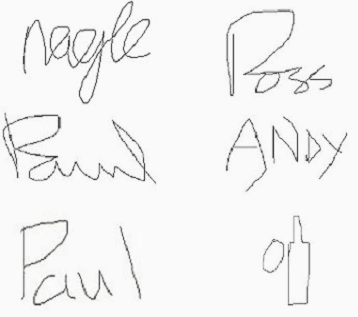A magazine where the digital world meets the real world.
On the web
- Home
- Browse by date
- Browse by topic
- Enter the maze
- Follow our blog
- Follow us on Twitter
- Resources for teachers
- Subscribe
In print
What is cs4fn?
- About us
- Contact us
- Partners
- Privacy and cookies
- Copyright and contributions
- Links to other fun sites
- Complete our questionnaire, give us feedback
Search:
The Biometric Mouse
Peter McOwen and Ross Everitt of Queen Mary have invented a new way to check your identity online using a kind of biometrics without grisly consequences. It could make shopping over the Internet much more secure and give people more confidence buying online. It could even replace signatures and chip and PIN in supermarkets. Face-to-face and on paper people have always used a signature - writing their name to prove their identity and authorise cheques or other documents. Online, rather than a written signature, passwords and the like are used instead. Unfortunately they are prone to lots of security problems. Even if the password system is technically insecure because people use ones that are easy to guess, write them down, allow others to see them typed in, and so in. More futuristic forms of identification mechanism use "biometrics" - some unique physical characteristic of the person such as fingerprints, iris scans or the like. Some have suggested that the biometric industry could reach many tens of billions of dollars in revenue in 5 or 6 years time (its already worth several billion dollars). However, most biometric systems need special hardware of some kind to measure the characteristic. They can also carry a stigma as do fingerprints as well as raising privacy problems.

The biometric mouse signature system provides a way for people to use a written signature similar to the pencil and paper version online when using a desktop computer without any special hardware - the software works with any standard Java enabled web browser. The person uses a written signature, just as with paper but writes it with their mouse. The clever part is that it is not just the pattern on the screen that matters but the pattern of mouse movements to create it. Sophisticated artificial intelligence software learns the way that the person writes the signature and matches any subsequent writing of the signature against it. It can also adjust to the gradual change of a signature over time - a problem with a pencil and paper signature. A fraudulent attempt to sign a document needs more than just the pattern itself but to be able to copy the way it was done. Ideas like this mean in future you may not be trying to remember yet another PIN or password to login, but just going back to (almost) old fashioned signing your name.
More Biometrics
Interested in a grisly story about digits?The Maze

There is a couple eating in the next room, waiters hovering.

Next door is a padded cell where somone is screaming his head off as smoke rises from a computer in the corner


